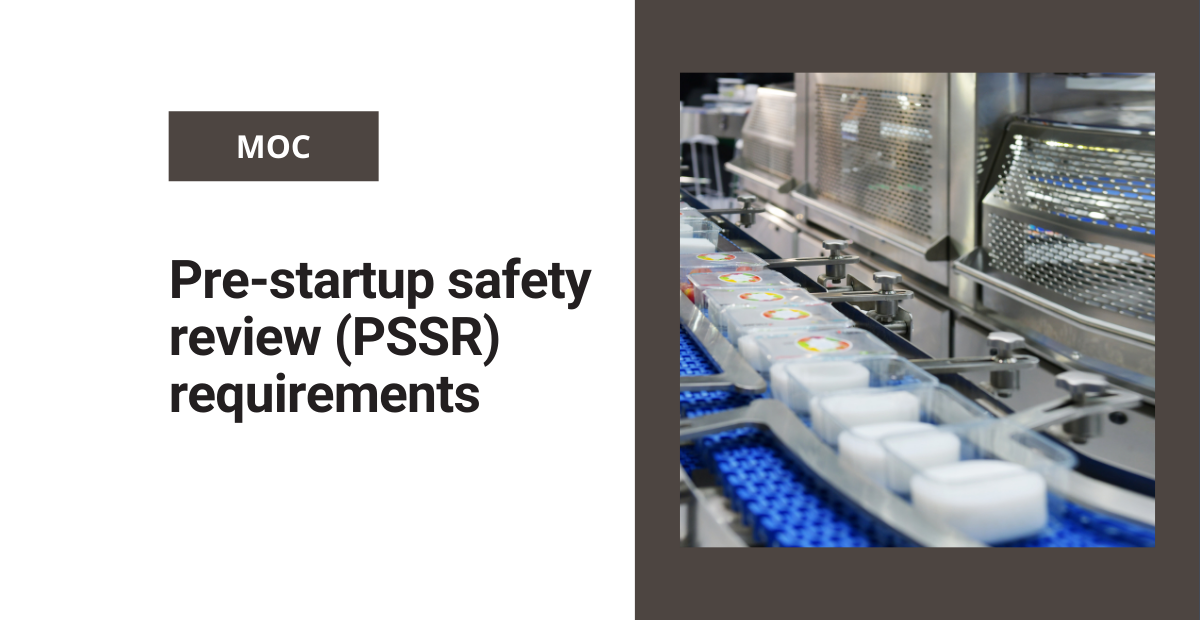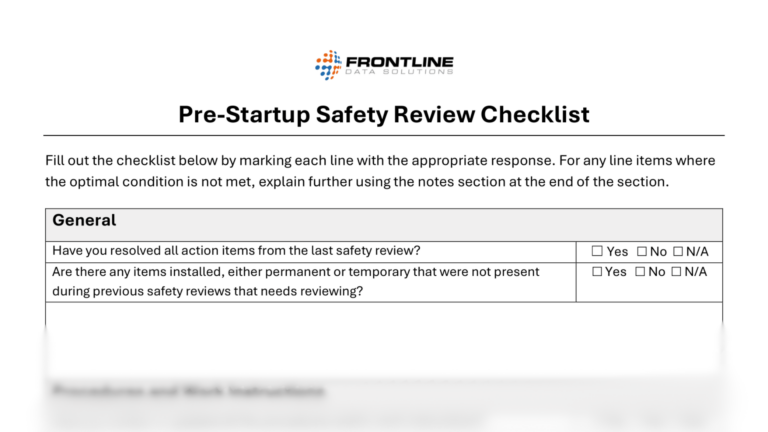OSHA’s process safety management (PSM) standard is designed to protect workers from hazards that come from any modifications to workplace processes. Before you can launch a new or modified system, you need to do a pre-startup safety review (PSSR).
Firstly, this review encompasses everything from chemicals and equipment to workstation and personnel changes, all of which contribute to the overall safety of the system. Secondly, without this crucial step in your implementation plan, you could be putting your workers at risk for a serious incident.
What is PSSR?
Firstly, a PSSR is a review that checks for potential hazards and issues with a new or modified process, system, or piece of equipment before you implement it. Secondly, this type of review helps prevent unforeseen hazards from causing a major safety incident.
Firstly, PSSRs are most effective when people outside of the project team complete them. Secondly, this approach eliminates any bias that might otherwise lead to a critical oversight. Finally, an effective pre-startup safety review must follow a structured, documented, and detailed approach.
Additionally, when you provide proper documentation and a comprehensive overview of the new process, system, or equipment, the auditor can more easily catch potential hazards.
A PSSR provides a documented review of new or modified equipment, systems, and facilities to confirm that:
- Adequate safety, operation, and maintenance procedures are in place.
- Designers and builders construct new facilities with adequate engineering controls.
- The company controls hazardous processes appropriately.
- The team follows the quality risk management process to ensure that no significant hazards are present.
- Your team assesses changes for their potential impact on safety and quality.
- Finally, your organization manages any identified risks effectively.
The thoroughness of this process means that safety incidents are less likely to occur. However, when you complete a PSSR, you can review far more than just operational processes and equipment.
Free checklist!
Download one of our PSSR checklists to get started creating a site-specific document for your team to fill out.
What is considered a startup?
The term “startup” refers to any procedure that activates a process, piece of equipment, or system. Organizations typically perform PSSRs after an operational shutdown that has altered the facility in some way. Aside from shutdowns, startups can also be part of routine maintenance activities, such as equipment troubleshooting and repair.
There are three main types of startups to consider:
- Preventative maintenance
- Corrective maintenance
- System startups
Firstly, quality assurance (QA) and quality control (QC) both play a crucial role in chemical manufacturing. Secondly, they help ensure that manufactured products meet the regulatory requirements. Finally, in this post, I’ll outline the difference between quality assurance vs. quality control in chemical manufacturing and explain the benefits of each method.
What is included in a PSSR?
Firstly, the overall PSSR process is relatively simple. Secondly, you must view a system objectively when you review it for potential issues. Finally, that’s why someone outside of the project or operations team should complete the PSSR.
A standard pre-startup safety review includes:
Document review: A check for mandatory documents like equipment user manuals, safety checklists, hazardous material handling instructions, emergency protocols, etc.
Site audit: A walkthrough of the site equipment, process, layout, systems, etc. for proper configuration and general safety
Implementation plan review: A review of the site’s plan for starting up the new/modified equipment, process, or system
In each part of the PSSR, you should note where you see deficiencies and create a system for tracking their solutions. For example, if you note that certain safety signs are missing, you need to create an action item to have them replaced. Beforehand, make sure you take care of these action items and document the results.
OSHA PSSR requirements
PSSR requirements come from three primary sources:
- OSHA – Occupational Health and Safety Administration
- EPA – Environmental Protection Agency
- HSE – Health and Safety Executive
Cal/OSHA states, in 8 CCR Section 5194.1(a)(2), that:
“A covered employer shall develop, implement and maintain a written process safety management program designed to prevent or mitigate hazards associated with hazardous chemicals used by the employer”.
EPA/Cal ARP states, in 40 CFR (Code of Federal Regulations) Part 68.110(a), states that:
“Each owner or operator subject to this subpart shall develop and implement a risk management program that is designed to prevent or minimize catastrophic releases of regulated substances.”
According to HSE Policy No. 2:
“The organization must have in place a documented, formal process safety management system to be applied throughout the organization which will ensure that process safety risks are properly identified and controlled.”
Firstly, the commonality between all three regulations is that businesses must have a PSM system in place to prevent workplace hazards. Secondly, PSSRs are just one important piece of this larger puzzle, but they are still essential for ensuring a safe work environment.
Finally, remember that PSSRs are helpful for multiple types of process changes. Whether you’re introducing a new chemical, upgrading your technology, or making personnel changes within the process itself, a PSSR helps you find and correct hazards before they create dangerous and potentially life-threatening situations.





